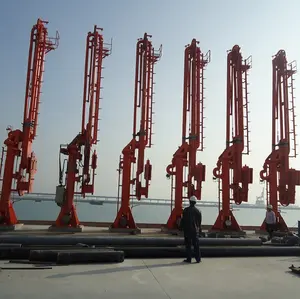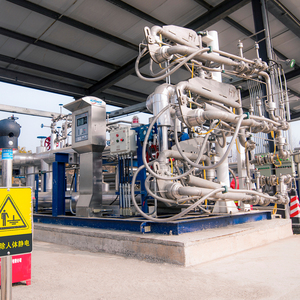(36 products available)











































































































































































LNG loading arms are multipurpose, flexible pipes for transferring Liquefied Natural Gas (LNG) between ships and terminals.
Multi-Function Loading Arms:
Multi-function loading arms are flexible pipes showing the ability to load and unload LNG from ships to onshore facilities or vice versa. They usually consist of several segments with an integral middle section, enabling lateral and vertical movements.
Example: Stangas LNG ship loader.
Dedicated Loading Arms:
They are specially designed for either loading or unloading LNG. While dedicated loading arms prioritize the transfer of LNG from ships to onshore facilities, dedicated unloading arms focus on importing LNG from offshore vessels to onshore terminals.
Example: A dedicated loading arm might have a terminal connection with more elaborate safety features, while a dedicated unloading arm would incorporate transfer pumps and storage tank connectivity.
Mid-Stream Transfer Arms:
That is for directly transferring LNG from one ship to another in open waters without docking at a terminal. Using the ship-to-ship loading arm can avoid building costly onshore facilities and expedite the delivery of LNG to regions with high energy demands.
Example: ANS Midstream Transfer System.
Floating LNG Hubs:
They are offshore floating platforms that can be used to provide an interim storage facility for newly arriving LNG carriers. Using an LNG loading arm can facilitate gas offloading and regasification of the gas into the local grid.
Example: Exmar allows to moor a gas carrier at a designated offshore position and subsequently connect an LNG loading arm.
The following statistics are vital for the wholesale purchasers of LNG loading arms who need to meet certain standards and profit by selling these products:
Materials
Special stainless steel grades that can withstand extremely low temperatures, such as carbon steel, are used in the construction of LNG loading arms. This helps ensure arm rigidity and performance when carrying or holding cryogenic liquids.
Flexible Section
Semi-rigid flexible cryogenic hoses or LNG loading arm bellows are employed. Both can counteract temperature-induced expansion or contraction of the ship while allowing some angular flexibility. They can also resist cryogenic temperatures (sometimes as low as -196°C) and high pressures (up to 50 bar).
Weight
LNG loading arms must be lightweight to avoid putting too much weight on the ship or dockside at the other end. This is achieved through appropriate design and material selection. Typically, the weight of straight retractable arms is around 6-10 tons; the weight of complex multi-segmented telescopic arms may be 15-30 tons or more. The actual arms for specific purposes can be checked via detailed discussions with suppliers.
Length/Reach
The reach of the arm determines which port facilities and a particular ship can be used for loading/unloading. Longer lengths are needed for the docking end of the arm. The lengths can typically range from 3 meters to 12 meters, telescoping out to whatever is necessary for a given operation, with 0.1-meter precision.
Connection Types
Both standard bayonet and splitter flanged connections are widely used now in the industry. However, standard connections will always be preferred for safe and seamless operations.
Following these recommendations can help maintain performance, safety, and comfort:
Regular Inspections
Regular checks should be done on all kinds of arms to see if there are any signs of wear and tear, such as cracks, corrosion, leaks, loose or damaged parts. Any LNG transfer arm that shows any signs of a problem should be taken out immediately and repaired before it is used again.
Lubrication
All moving parts of an LNG loading arm must be properly greased/ oiled according to the manufacturer's specifications to reduce wear and facilitate fluid transfer. Only lubricants approved by the manufacturer should be used to prevent contamination of the cargo and maintain product integrity.
Cleaning the Arm
When loading LNG, the risk of contamination is significant because impurities can get into the cryogenic liquid. So special care must be taken to clean loading arms that have been used to transport products that are not chemically identical to LNG. Operational guidelines should be followed to ensure that cleaning is done correctly and to avoid any cross-contamination.
Repair and Replacement
Loading arms are essential for the safe transfer of liquids; any loading arm that shows wear or tear should be replaced or repaired after a professional inspection. Only genuine spare parts should be used when any repairs are done to ensure safety compliance and operational efficiency.
Today, the global trend toward clean energy has resulted in a lively market for liquefied natural gas (LNG) worldwide. LNG loading arms are an integral part of the value chain. They facilitate the loading of LNG onto vessels in export terminals and the unloading of LNG from vessels in import terminals. The main buyers in the export market for LNG loading arms are large state-owned oil and gas companies who typically use telescopic arms with multiple flexible sections, mono-blocks, or T loading arms. They are also used at terminals, passenger and vehicle ferry ports, as well as at floating storage and regasification units (FSRUs) for offshore loading/unloading.
The majority of the population in Europe, the United States, China, and Japan depends on LNG as their primary energy source. China has made natural gas a priority to achieve its goal of reducing overall carbon emissions. Therefore, huge investments are being made in infrastructure, such as terminals, to facilitate imports. The opposite is true for the United States, which is exporting natural gas. Almost all terminals in these two countries use sophisticated loading arm technology, such as cryogenic swivel joints, to prevent leakage and fumigation hazards.
Because the cost of transporting LNG by ship is quite high, import-export countries use high-speed loading arms at their terminals. Therefore, the same LNG loading arm model may be used for both sides of the vessel, depending on the prevailing situation.
Although not all countries demand high-performance loading arm technology, the need for LNG worldwide means that loading arms are used in every country that wants to use this form of energy. Thus, LNG loading arms are good growth areas for loading arm manufacturers at all levels.
The following tips will help businesses to select reliable LNG loading arms.
Safety features
They should look for safety features such as anti-overturning devices, pressure relief valves, emergency stop buttons, and automatic disconnect devices. The presence of these safety features will help secure the safety of crew members, facilities, and products during unloading operations.
Flexible operation
They should consider the maneuverability of the loading arm. Choose an arm that is easy to adjust and has a wide operational range. A flexible operation will simplify the alignment and connection between the arm and the ship's cargo tank.
Durable materials
Consider arms made of materials with good wear resistance and corrosion resistance. This will ensure the longevity of the arm and reduce maintenance costs.
Cost-effectiveness
Consider the total lifetime cost of the bearing, including purchase cost, maintenance cost, energy consumption during operation, and any potential downtime costs. Evaluate its performance and reliability to determine its long-term cost-effectiveness.
Consider different types
Understand the advantages and limitations of various types of LNG loading arms, such as self-supporting, unstated or articulated loading arms. Choose the most suitable model according to specific operational needs and environmental conditions.
Q1. What Is The Difference Between An LNG Loading Arm And A Conventional Loading Arm?
A1. The main difference between an LNG loading arm and a conventional loading arm is that the former is designed to cater to cryogenic products. The materials used, the design, and additional features like insulation and anti-spill mechanisms set them apart from standard loading arms used for regular products.
Q2. Can LNG Loading Arms Be Used For Other Cryogenic Fluids?
A2. Yes, LNG loading arms can be used for other cryogenic fluids, such as liquid nitrogen or liquid oxygen. However, the specific design, dimensions, and insulation requirements of the arm must be evaluated if they are compatible with the other cryogenic fluids.
Q3. What Are The Future Trends In LNG Loading Arm Technology?
A3. The future of LNG loading arms may include advancements in materials for better insulation and durability, automation for enhanced safety and efficiency, and environmentally friendly designs to minimize product losses during transfers.
Q4. What Are The Benefits Of Using An LNG Loading Arm Over Other Transfer Methods?
A4. LNG loading arms offer several advantages, including safer transfer of cryogenic fluids, reduced risk of spillage or product loss, and flexibility in reaching the vessel's loading inlet. They also improve efficiency and streamline the docking operation.